The Splinter cell franchise has held a cult-like status among its legion of fans since it debuted on the Xbox in 2002. It has gone on to spawn three direct sequels, but even the series most dedicated followers would admit that they all play in an almost identical fashion. The same cannot be said of the latest title in the series: conviction. The engine and gameplay mechanics have been given a new lick of paint that completely reinvents the series’ dynamics. The game was initially slated for a late 2007 release date, but was mysteriously cancelled by Ubisoft, most likely so the crowd-based stealth shown in the May 2007 trailer for conviction wouldn’t be competing with Ubisoft’s contemporary stealth title: Assassin’s Creed. Ubi chose to delay Conviction and now it returns having been started from scratch since then. The wait has not been in vain. Whilst die-hard fans of the original games may dislike the new changes to their beloved franchise, the majority will find the progression from the trial and error of the first games, to the new found speed of the stealth and action in Conviction, a refreshing one.
In terms of additions to the core splinter cell gameplay mechanics it is easy to see that Conviction is what a true sequel should be. It retains the series focus on stealth and the interplay between use of weapons, melee attacks and gadgets, whilst adding the new mark and execute and last known position systems that alter the flow of the game for the greater good.
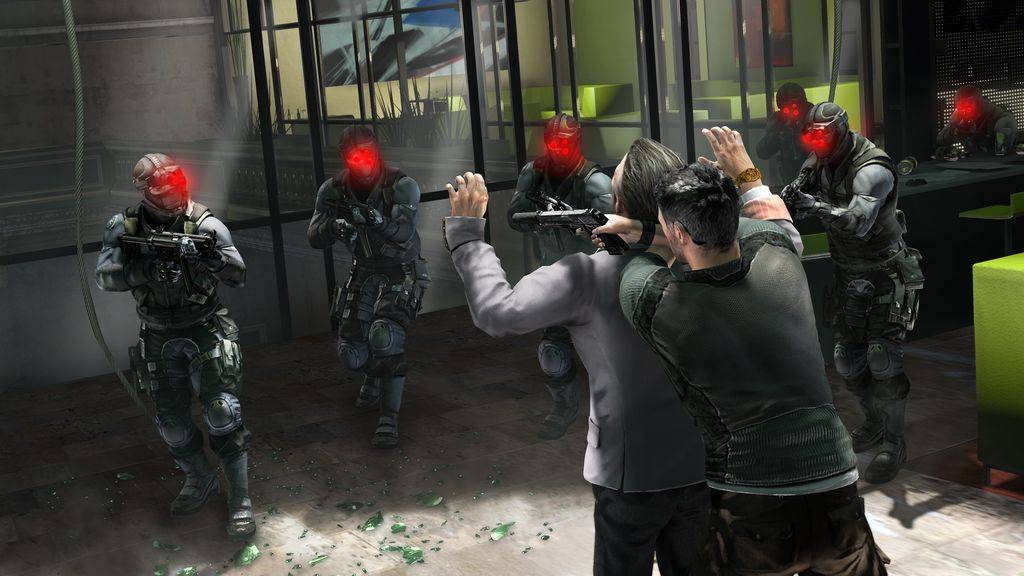
The balanced gameplay is easily the biggest draw of the game
Mark and execute is reasonably self explanatory. Whenever you get a line of sight on an enemy you can mark him by using the RB and with a simple press of the Y button the player can instantly headshot all marked enemies simultaneously. This isn’t as overpowered a mechanic as you may initially think as, not only must they be in range and in sight in order to perform the manoeuvre, but the player must earn the execution by getting a hand to hand kill. This mark and execute system feels just right, in that it empowers the player, whilst not overpowering them. Whereas in previous SC games, I would be forced to wait around groups of enemies until they split off individually, I can now drop on one of the enemies from above, mark his four friends during the kill animation and get the headshot on all four one after the other instantly. And yes, it is as bad-ass as it sounds. The addition of mark and execute is the most significant addition to the gameplay as, when combined with a healthy dose of aim assist, the player no longer feels like the mouse in a den of vipers. They become the hunter instead.
Just in case the proverbial excrement winds up hitting the rotary blades, players who have been detected can now fall back on their last known position. Just as it says, the game displays your position that was last seen by the enemy after you’re detected, provided you can break the line of sight with your AI assailants. A silhouette then appears showing where the enemies think you are. Combining this with mark and execute makes Conviction a less frustrating experience in comparison to other stealth titles, as you are seldom left without a safety net or ace up the sleeve.
One of the more surprising elements in the game is that of the cover system. The surprise in this case being a pleasant one. Conviction has one of the most robust cover systems in third person gaming to date. It just feels right and 99% of the time it does what you want it to do. Hopefully it will work as an inspiration for other third person shooter games that are yet to come. (Cough Gears of war 3 cough)
Other less obvious changes come in the form of visual cues to alert the player to how well they are hidden and to what they should be doing. The objectives are no longer given to you on a seperate menu screen, but are instead projected onto the landscape as you play. This further streamlines the experience and, whilst it’s not a game changing feature, it’s nice to see innovation being sought after in both presentation and gameplay. Less effective is the lighting system. Rather than use sound and light meters made popular in previous entries to the series, things have been simplified and now the colour bleeds out of the screen to show that the player is hidden in the shadows. This works well enough and does inform you of your visibility in a concise manner, but it meant that I found myself playing through nearly the entire game in black and white. Combining this with the absence of dedicated night vision goggles made navigating through the shadows more irritating than it should’ve been. I’m just grateful I was able to turn up my brightness setting mid-game.
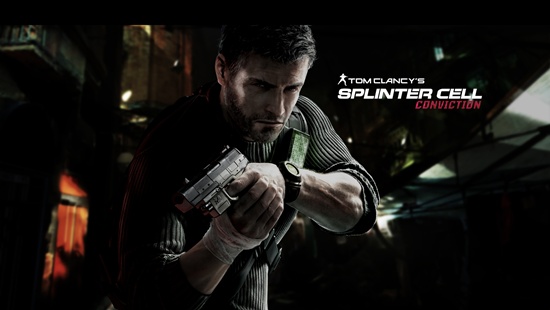
Sam Fisher is back with a bang!
It’s interesting to see features from other Tom Clancy games influencing part of Conviction as well. The Persistent Elite Creation system (or PEC) makes its way from Rainbow Six Vegas 2, and continues to act as a levelling up system that runs through the whole game regardless of what mode you play. Rather than give you XP for each action though, instead the player is given challenges that reward PEC points. These can then be used to upgrade your weapons, armour and gadgets that are useable in any of the game modes. It’s a nice system that adds a natural sense of progression, but it becomes a bit fiddly going into the menu to check challenge progress (especially during an online co-op session) and the challenges range in quality as well.
Some mechanics of the game are exclusive to the co-op parts of the game. As in most co-operative shooter games, if your partner falls in battle you can revive them so long as you reach them in time. If a player goes down, they aren’t out entirely as they can sit up and provide covering fire with their side arm. Irritatingly though, the moment you sit up to try and shoot while you’re down, all enemies seem to direct their fire at you. Should you lose all your health while you’re down you have to load your last checkpoint. You’ll find yourself repeating this process; a lot, especially seeing as how most enemies can finish you off while you’re down in almost one shot. More interesting is that the AI can attempt to take the player into a chokehold in co-op. If you find yourself being strangled by a foe, it’s up to your partner to save the day. This is a more daring co-op mechanic than is employed by most shooters, but it comes with mixed results. You’ll find yourself in a chokehold if the enemy gets the drop on you, but they can also reverse your attempts at hand to hand kills if they spot you first. Though this is reasonable in theory it became annoying in practice, as it seems entirely random when the game decides it will and won’t let you melee your opponents unchallenged. It’s not a game breaker, but it cued its fair share of curse words down the headset. Fingers crossed it will be patched in the near future to make it a little temperamental.
The core meat of the Conviction experience will be in the form of the single player story. Whilst there’s a lot to love in the main story it’s a tiny bit on the short side, but it’s always the good things that come in small packages. Once again you take control of Sam Fisher following hot on the heels of the story from the previous entry in the series: Double Agent. Don’t worry if you missed it though, as any blanks in the plot are filled in well enough. Having discovered at the end of Double Agent that his daughter was killed, Sam sets off to find her killer. It’s a simple premise but it gives the game a greater sense of narrative progression than the usual terrorist plots that were the crux of previous Splinter Cell titles. It’s nice to see a more emotionally engaging plot in a Splinter Cell game, and we see this change occurring within our protagonist as well. Sam Fisher is pissed off and it shows throughout the game. The hand to hand kills are brutal (not to mention oddly satisfying) and the new interrogation sections follow in the same footsteps. Sam finds himself having to beat information out of key figures at points in the story and these moments are cinematic enough to give a nice break in the action. That said, they all essentially revolve around you pressing the B button on occasion and they tend to wear a little thin on a second playthrough.
The narrative tries a few new tricks throughout the story and there are enough twists, turns and time shifts in the plot to keep players on their toes. It won’t win any awards but it’s a functional and gripping tale that you’ll want to see through to its conclusion. Level design throughout is pretty solid but the game loses its way during a few sections. One level pits you in a flashback during Sam’s time as a soldier in Iraq, as possibly a nod to other popular shooters (cough modern warfare cough). Whilst the use of character narrative is effective in the level, it cripples the flow of the game by removing many of the gadgets, guns and mechanics you tend to rely on during the earlier levels. I saw what they were trying to do, but it was poorly executed and extremely frustrating on the higher difficulty levels. Likewise the last section of the game tries to crescendo to a climactic finish by making the game more action packed. Again, it’s clear what the goal was but it seems Ubisoft missed the post, as the game loses the emphasis on stealth that was so enjoyable during the earlier levels.
So 5-6 hours later and you’ve finished the story. If this was all you wanted out of the game then you’re entitled to feel a little ripped off, if however you fancy some multiplayer then Conviction has enough modes to keep you satisfied. Splinter Cell loyalists may be sad to hear that the quirky and competitive spy vs. mercenaries mode from Double Agent is out, in favour of a dedicated co-operative experience akin to that of Splinter Cell Chaos Theory. It features its own co-op campaign that serves as a prequel to the single player campaign. This story mode is just as fun as its single player counterpart, weighing in at roughly the same length. Whilst the level design is a bit more stable than the single player, the plot is naturally a little more basic as well. That said the conclusion uses a very strong fragmented narrative that will be one of the gaming moments I’ll take to my grave, though be warned it is best enjoyed either online or in system link.
While we’re on the topic of connection types for co-op, it’s very pleasing to see a developer understanding that split screen is not dead. Indeed Ubisoft have covered all the bases allowing split screen, system link and online play over Xbox live. Ubi truly deserve a medal for including split-screen and system link, as whilst I’m strongly in favour of online gaming, you just can’t high five a buddy unless they’re in the room with you.
If the co-operative campaign wasn’t enough for you then you can take solace in the various challenge modes known as deniable ops. These can be done either solo or with a friend and consist of both co-op and competitive modes. In hunter you have to sneak through a level eliminating all hostiles, and if you’re seen reinforcements are called in, who must also be eliminated. Infiltration is a mode that’s unlockable through Uplay points earned in the game and is the same as hunter except you can’t be seen at all. These two modes are the bread and butter of deniable ops and are what co-op should be about. My only criticism is that there are only six maps to play on, four of which are ripped straight from the co-op campaign. It’s a shame really as, with a few more levels, this really could’ve been an addictive way to kill an evening or three with a buddy. That said, Ubisoft have claimed they will provide free DLC for the game every Thursday, so it seems new maps will be on the horizon.
If you get tired of co-ordinating your attacks with your mate and just want to shoot him in the head you can jump into the competitive face-off mode. The mode consists of you, your opponent and various AI. Points are awarded for each AI kill and lots of points are given for eliminating the other human player. Whoever has the most points at the end wins that round and the first to three rounds wins the game. It’s simple and fun, and whilst it’s not tight enough to be a halo-beater, it serves as a nice distraction from the other modes.
Last of the deniable ops modes is ironically called last stand. It tasks you with defending an EMP generator from waves of enemies, who are out to blow it up. It’s a nice effort at a horde-style mode, but doesn’t really work well in a Splinter Cell game. It takes the worst parts of the experience and condenses them all into one game mode. It’s curious then that this is the mode that has the most maps. Whilst the hectic nature will provide the odd moment of enjoyment, you’re probably better off leaving this mode alone unless you’re going for 100% completion.
To help you through your various modes are a myriad of armours, weapons, gadgets and upgrades for all of them. Whilst you have a choice of nightmares I didn’t get the impression that the guns were particularly balanced. Once you get the silenced and scoped MP5 I found little desire to try the other guns, and the pistols weren’t much more evenly matched. Likewise some of the gadgets seemed a little unnecessary. Why do I need an EMP grenade, EMP backpack and a flashbang if all three do the same thing? I suppose it sounds a little silly to complain when there is so much choice to be had, but I think a bit more thought could have gone into making all the weapons and gadgets have their own strengths and uses.
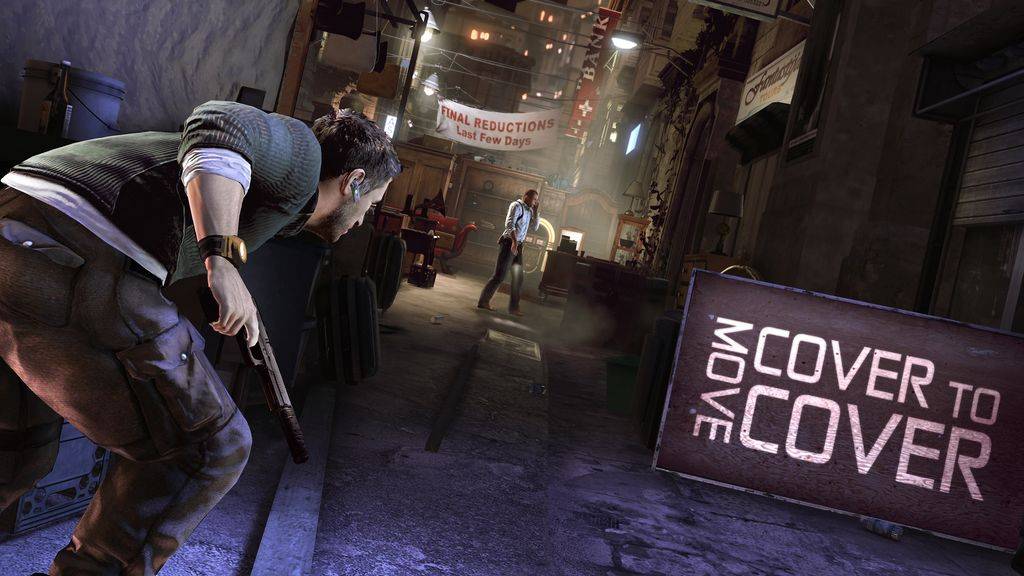
The visual design is outstanding
The whole visual style of Conviction fits in with the more emotionally engaging plot and the angry new Sam Fisher. The art direction in general gravitates toward a gritty, film noir style that makes Conviction’s visuals a clear evolution from previous entries in the series
As far as the quality of graphics goes in Conviction it’s a mixed bag in a rather curious way. Most of the time in games we see these beautiful, photo-realistic CG cutscenes and then the in-game graphics aren’t quite as good. In Conviction however, we see this process in reverse. The graphics in-game are a little on the plastic and shiny side but they’re as smooth as you can get and just scream next- gen HD era graphics. Yet by comparison the cut scenes are embarrassing and look hideously outdated. When I first saw a mug-shot of Fisher I thought he had some newspaper stuck to his face, until I realised it was poorly rendered stubble. Yet when I swung the camera round to the same place during gameplay his beard looked… Well like a beard should in a current generation game. It’s a small gripe and I’m glad at least that the game looks the part while you’re actually playing it, but it seems a shame that such a small weakness was let through quality control as it breaks the immersion somewhat.
The audio in Conviction is sadly its weakest part. It’s not that there is anything necessarily bad about it but, in comparison to the rest of the package, I found that the music and effects failed to grab my attention. The soundtrack works well enough throughout and mimics the dynamics of the game well, but it seems a fairly standard spy film affair and won’t have you running out the door to get the CD. One aspect of the music that really caught my attention was the use of genre. Unfortunately it caught my attention for the wrong reasons. I can see the logic. The player has been detected, how can I get their blood pumping? I know why don’t I put some techno drum and bass grooves in here? Maybe if this was jet set radio or mass effect, but in the Splinter Cell universe it just felt out of place.
The voice acting will be a familiar affair to series loyalists as we have Michael Ironside returning to voice our gruff talking protagonist. The only other returning character, Anna Grimsdottir, is also once again voiced by her original voice actor: Adriana Anderson. Needless to say, if you enjoyed the voice acting of the original games or any spy game/movie, you won’t feel out of luck here.
Conviction is one of the few games that excited me enough that I took the time to get all 1000 gamerscore from it, and for good reason. Like it or not, Conviction is a true sequel that has sought after a new style of gameplay, but set it in the same world that old fans of the series will find pleasing and familiar. It took a leap of faith and is all the better for it. Whilst there is a definite lack of maps for deniable ops the promise of weekly DLC helps to assuage the pain and until then there is more than enough content to justify the £40 admission price. If Ubi can build on the mistakes of conviction, then the next Splinter Cell will be one to watch. Until then there’s a whole lot of game to get through and no time to waste. Even if you have your doubts, I’d recommend picking up a copy anyway as Conviction has a lot to offer.
This game was reviewed on the Xbox 360.
Awesome gameplay mechanics, there’s a lot to love in the main story
Single Player campaign is extremely short, audio in Conviction is its weakest part











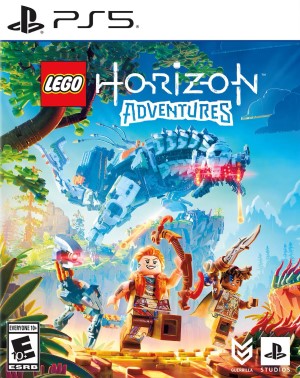
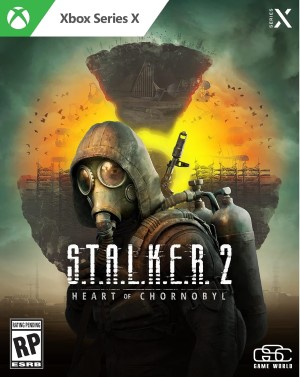




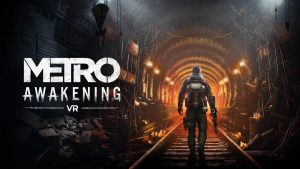
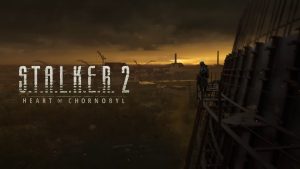
Share Your Thoughts Below (Always follow our comments policy!)